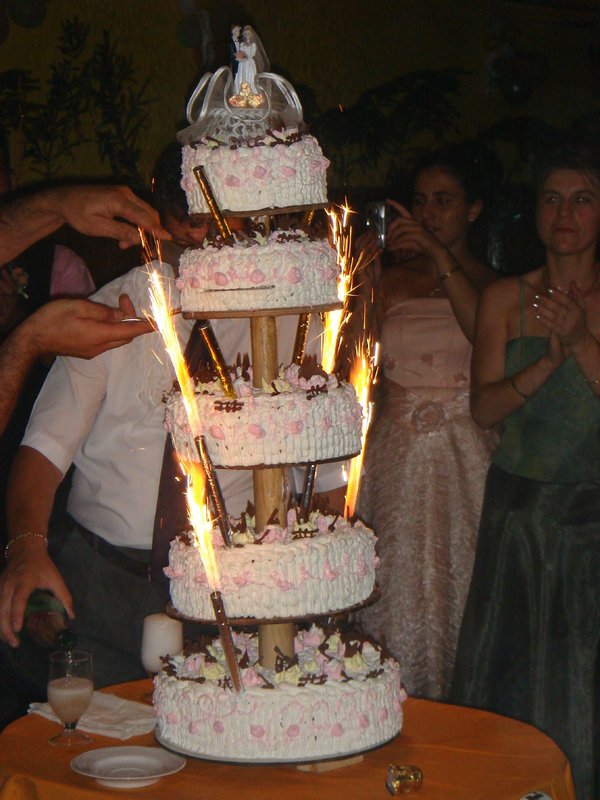Romanian Wedding
Romanian weddings typically take place on Saturdays or Sundays and include both a civil ceremony and a church wedding, with roles for best man, bridesmaids, and godparents who assist in various aspects of the ceremony and preparations. Key traditions include the groom arriving at the bride's home with pine trees for good luck, a symbolic shaving ritual, the breaking of bridal bread, and the unique "kidnapping" of the bride by the groom's friends. Celebrations continue with a lively reception featuring traditional dances like the "hora," and special ceremonies such as "legatoarea," where the bride's veil is removed to symbolize her transition to married life.
Romanian Wedding
The weddings in Romania are usually held on Saturday or Sunday. The civil ceremony in the state office is obligatory.
Each wedding includes a best man, bridesmaides and godparents ("naşi"). A godfather is "naşul" while a godmother is "naşa".
The best man and bridesmaids must be single. A godparent can be a friend or a cousin. He or she must be married in church.
The godparent has many roles. For example, she and bridesmaides help a bride to get dressed.
The groom traditionally arrives to the bride's home to take her to the wedding ceremony. The groom is accompanied by his friends. They bring some pine trees. Before entering the house they leave them there. This is done for good luck.
There is also some shaving. A best man shaves the groom with a blunt knife. A bride and groom dance with other people. After this dance they are allowed to sit. Then a sweet bridal bread ("turta miresei") is broken above the bride's head by her mother and the godmother.
There is a tradition saying that is extremely bad luck is a bride sees another one on her wedding day.
Most Romanians are Orthodox Christians. Before entering a church everyone is supposed to put some coins into the bucket of water put next to the main church door.
The church wedding lasts for some half an hour. There are readings from the Bible. As part of the ceremony a bride and groom eat some bread and drink wine. A godmother stands next to the bride and holds about a metre high candle with flower ornaments.
The bride and groom wear special crowns. The ceremony ends with a dance of the newlyweds, their parents and godparents around the main church table.
When getting out of the church newlyweds kick the already mentioned bucket spill out the water. This water symbolizes their future problems.
A kidnapping of a bride is tradition appearing in quite many countries. Romania is one of them. The kidnapping is done by the groom's friends. They hide her in a local bar. Then they phone a groom demanding a ransom. Short negotiations begin. After few minutes the groom accepts the conditions and the bride is returned to the wedding reception.
The ransom is not money. The kidnappers are quite satisfied with few bottles of some good alcoholic beverage. But there are also communties where the groom is asked to make a speech all about his undeniable love for the bride.
Some people do not organize the kidnapping in the traditional way. There some kids just stole bride's shoes.
One of dishes served at the Romanian wedding reception is "sarmale". This dish includes leaves of sour cabbage stuffed with mince meat and rice. Before this dish is eaten everyone says the Christian prayer Our Father.

The wedding cake is cut together by a bride and groom. It is usually made with various fruit.
A special dance known as "hora" is performed after serving of the cake. First a bride and all the female guests start to dance. Men can join them but for this privilege they have to pay some money. The bride gets all the collected money.
There is a famous Romanian song performed at every wedding. It is "Say goodbye, dear bride (to your father and your mother)".
Close to the end of wedding reception a tradition known as "legatoarea" ("binding") is performed. A bride is sitting on a special chair and a godmother takes off a bride's veil. But it is not easy. A bride traditionally refuses it three times.
After the godmother finally manges to remove the veil a scarf is put on the bride's head. The whole act should show that a bride is not a girl anymore but a married woman.
A bride then puts the veil is put on a head of the single woman who manages to catch the bridal flower bouquet after being thrown by the bride towards a group of single women.
Guests are expected to bring money as a wedding present. They put it in an envelope and give it to the couple when leaving the wedding reception.
That is not all. In the morning after the wedding reception there are two more parties. The first one is held in the bride's home while the second one is held in the groom's home. The newlyweds are expected to go to both parties.
A special soup called "ciorba de potroace" is served at those parties. It is made with cabbage and different poultry giblets. Recipes differ from region to region. It is believed that this dish is very good against the hangover.
References
A romanian wedding: traditions and superstitions –
Learn about kidnapping the bride, money gifts and
the vow of submission
http://touristinromania.net/amazing-hidden-places-and-facts-in-romania/romanian-wedding-traditions/
Romanian wedding traditions
http://ioanaole.com/en/misc/romanian-wedding-traditions/
A bit about a Romanian wedding...
https://alanandlavi.wordpress.com/2014/03/10/a-bit-about-a-romanian-wedding/
Romanian wedding traditions – Ana-Elena and Bogdan
http://henrygomez.com.au/2010/07/romanian-wedding-traditions-ana-elena-bogdan/
photography
A Romanian Wedding Cake (photo by Kevin Hutchinson, Flickr)
https://www.flickr.com/photos/hutchike/204203929/
Creative Commons - File:Bran Castle030.jpg